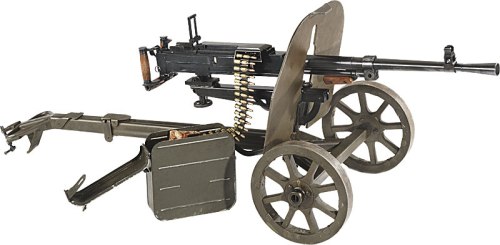The SG43 was designed by P.M. Goryunovin 1942 to provide a wartime replacement for the elderly Maxim Model 1910, and even used the old Maxim’s wheeled carriage.
The Degtyerev DP Model 1928 was a major Soviet light machine-gun during World War II. Simple and robust, the DP could stand rough treatment and extremes of weather. It can still be found in the hands of guerrilla groups all over the world.
If there has ever been one factor differentiating Russian and Soviet machine-gun designs from those of other nations it was the simple factor of weight. For many years these machine-guns were built to such a standard of robustness that weight alone was used as a means of incorporating strength, the ultimate example being the old M1910 Maxim guns that almost resembled small artillery pieces with their wheeled and shielded carriages. Eventually this avoidable trait was recognized by the Red Army when mobility made its way into long-term planning and by the mid-1930s, when a new heavy machine-gun was required, emphasis being placed more on design than sheer mass for strength.
The new heavy machine-gun was intended to be in the same class as the 12.7-mm (0.5-m) Browning, but the Soviet equivalent turned out to be slightly lighter. It used a 12.7-mm (0.5- in) cartridge and was intended for a variety of roles. To the credit of the new design, the DShK 1938 (in full the Krasnoi Pulemet Degtyereva-Shpagma obrazets 1938g), has proved to be almost as successful as the Browning, for it is still in production, albeit in a post-war modified form as the DShK 1938/46, and is still in widespread service.
If the DShK 1938 was lighter as a gun than the Browning the same could not be said of the mount, for as an infantry gun the DshK1938 retained the old wheeled carriage of the M1910, but a special anti-aircraft tripod was introduced and is still in use, The type became a virtual fixture on most Soviet tanks from the JS-2 heavy tanks onwards, and the Czechs have produced a quadruple mounting with DShK 1938s for anti-aircraft use. There was even a special version for use on armoured trains.
The smaller SG43 was introduced during 1943 to replace earlier 7.62-mm (0.3-in) machine-guns, including the venerable M1910. During the initial phases of the German invasion of the USSR the Soviet forces lost huge amounts of material, including machine-guns, and if their new production facilities were to replace these losses they might as well be modern designs. Thus the Stankovu Pulemet Goryunova obrazets 1943g came into being. It was a gas-operated and air-cooled design that combined several operating principles (including the well-established Browning principles), but overall the design was original and soon proved to be sound. As the SG43 the design was issued in very large numbers and even today the basic weapon is still in widespread use, albeit in a much modified and upgraded form as the SGM.
Both the SG43 and the larger DShK 1938 have the same basic operational: simplicity. Working parts have been kept to a minimum and very little routine maintenance apart from simple cleaning is required. Both designs can operate under extremes of temperature and they are most forgiving of dirt and dust in the works. In other words both suit exactly the type of environment in which they will be used.
Specification
DSnK1938
Calibre: 12.7 mm (0.5 in)
Length: 1602 mm (63.1 in)
Length of barrel: 1002 mm (39.45 in)
Weight: 33.3 kg (73.5 lb)
Muzzle velocity: 843 m (2,765 ft) per second
Rate of fire, cyclic: 550-600 rpm
Feed: 50-round metal-link belt (five belts joined)
Specification
SG43
Calibre: 7.62 mm (0.3 in)
Length: 1120 mm (44.1 in)
Length of barrel: 719 mm (28,3 in)
Weight: 13,8 kg (30.4 lb)
Muzzle velocity: 863 m (2,830 ft) per second
Rate of fire, cyclic: 500-640 rpm
Feed: 50-round metal-link belt
